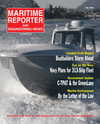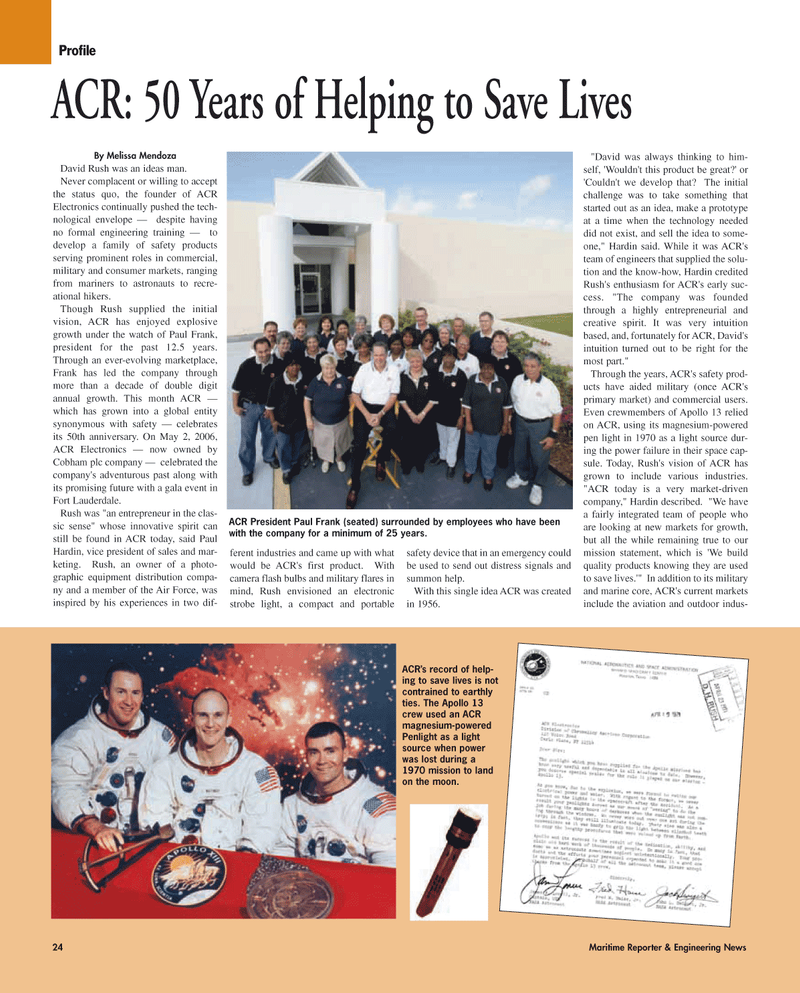
Page 24: of Maritime Reporter Magazine (May 2006)
The Marine Enviroment
Read this page in Pdf, Flash or Html5 edition of May 2006 Maritime Reporter Magazine
By Melissa Mendoza
David Rush was an ideas man.
Never complacent or willing to accept the status quo, the founder of ACR
Electronics continually pushed the tech- nological envelope — despite having no formal engineering training — to develop a family of safety products serving prominent roles in commercial, military and consumer markets, ranging from mariners to astronauts to recre- ational hikers.
Though Rush supplied the initial vision, ACR has enjoyed explosive growth under the watch of Paul Frank, president for the past 12.5 years.
Through an ever-evolving marketplace,
Frank has led the company through more than a decade of double digit annual growth. This month ACR — which has grown into a global entity synonymous with safety — celebrates its 50th anniversary. On May 2, 2006,
ACR Electronics — now owned by
Cobham plc company — celebrated the company's adventurous past along with its promising future with a gala event in
Fort Lauderdale.
Rush was "an entrepreneur in the clas- sic sense" whose innovative spirit can still be found in ACR today, said Paul
Hardin, vice president of sales and mar- keting. Rush, an owner of a photo- graphic equipment distribution compa- ny and a member of the Air Force, was inspired by his experiences in two dif- ferent industries and came up with what would be ACR's first product. With camera flash bulbs and military flares in mind, Rush envisioned an electronic strobe light, a compact and portable safety device that in an emergency could be used to send out distress signals and summon help.
With this single idea ACR was created in 1956. "David was always thinking to him- self, 'Wouldn't this product be great?' or 'Couldn't we develop that? The initial challenge was to take something that started out as an idea, make a prototype at a time when the technology needed did not exist, and sell the idea to some- one," Hardin said. While it was ACR's team of engineers that supplied the solu- tion and the know-how, Hardin credited
Rush's enthusiasm for ACR's early suc- cess. "The company was founded through a highly entrepreneurial and creative spirit. It was very intuition based, and, fortunately for ACR, David's intuition turned out to be right for the most part."
Through the years, ACR's safety prod- ucts have aided military (once ACR's primary market) and commercial users.
Even crewmembers of Apollo 13 relied on ACR, using its magnesium-powered pen light in 1970 as a light source dur- ing the power failure in their space cap- sule. Today, Rush's vision of ACR has grown to include various industries. "ACR today is a very market-driven company," Hardin described. "We have a fairly integrated team of people who are looking at new markets for growth, but all the while remaining true to our mission statement, which is 'We build quality products knowing they are used to save lives.'" In addition to its military and marine core, ACR's current markets include the aviation and outdoor indus-
Profile
ACR: 50 Years of Helping to Save Lives
ACR President Paul Frank (seated) surrounded by employees who have been with the company for a minimum of 25 years. 24 Maritime Reporter & Engineering News
ACR’s record of help- ing to save lives is not contrained to earthly ties. The Apollo 13 crew used an ACR magnesium-powered
Penlight as a light source when power was lost during a 1970 mission to land on the moon.
MR MAY2006 #3 (17-24).qxd 5/8/2006 11:27 AM Page 24

 23
23

 25
25
